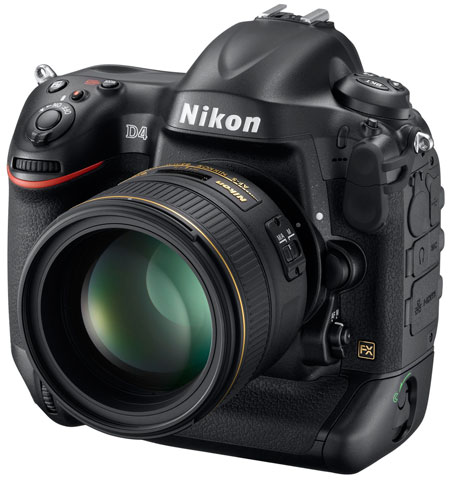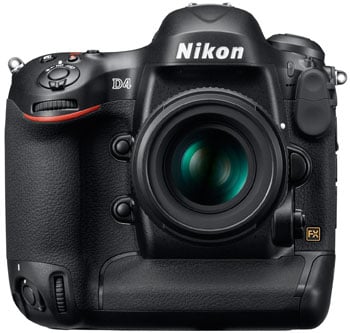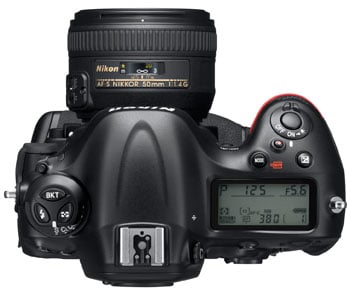Nikon D4
-
-
Written by Gordon Laing
The Nikon D4 is the company’s new flagship professional sports DSLR. Announced in January 2012, it replaces the D3s with upgrades in resolution, movie capabilities, AF performance, metering and connectivity. The previous D3s was optimised for speed and sold alongside the externally-similar, but higher resolution D3x for those who demanded the maximum detail. It’s currently unknown if there’ll be a high-res D4x to accompany the D4, but a torrent of rumours and leaks suggests the next high resolution full-frame body from Nikon will be the upcoming D800.
The headline specification of the D4 is a new 16.2 Megapixel full-frame FX-format CMOS sensor, up from the 12.1 Megapixels of its predecessor. The sensitivity now runs from 100 to 12800 ISO, expandable down to 50 ISO and all the way up to 204,800 ISO – that’s double the maximum and half the lowest sensitivity options on the earlier D3s. As before there’s two memory card slots, but while one remains for Compact Flash, the other accommodates the new XQD card format. This is a nice upgrade, although it does mean anyone wanting to record to two cards at the same time for redundancy will have to invest in the new XQD format.
The Movie capabilities have been significantly improved with the choice of 1080p in 24, 25 or 30fps, along with 720p at 25, 30, 50 or 60fps. Three frame sizes are also available for 1080p video: FX, DX and a 1:1 crop which effectively reduces the field of view by 2.7 times. Impressively the D4 also features a 3.5mm headphone jack for monitoring audio and an uncompressed 1080i HDMI output for those who either want to drive an external monitor while filming or record and encode using an external solution. There’s also a new adjustable aperture control for use when filming. Suffice it to say the D4 additionally offers an external microphone input and you have the chance to adjust the levels of both this and the headphones.
 |
Continuous shooting in the FX-format with autofocus has been boosted very slightly from 9 to 10fps, or 11fps with the focus and exposure locked. Fit an XQD memory card and you could fire-off up to 100 RAW files at 10fps. Autofocus duties are performed by the ‘Advanced’ Multi-CAM 3500FX AF sensor, sporting the same 51 AF points (15 of which are cross-type sensors) as the plain Multi-CAM 3500FX in the earlier D3s, but this time the advanced part refers to its ability to autofocus at slower apertures between f5.6 and f8, albeit with a reduced number of 11 AF points. This sounds like a minor tweak, but will be welcomed by anyone who uses tele-converters and previously found themselves limited to manual focus only.
The metering sensor receives a significant upgrade from the 1004-pixel model in the D3s to the brand new Advanced Scene Recognition System which boasts a whopping 91k pixels. This allows the metering system to actually offer face detection and automatically meter for human subjects even when you’re composing with the optical viewfinder (although you won’t see frames around faces). Information from the sensor is also used to aid AF, flash control and white balance.
Externally the screen has been enlarged from 3 to 3.2in, albeit sporting the same 921k resolution and 4:3 aspect ratio as before; there’s no touch-interface or articulated mount. A very welcome – and strangely overdue – feature are backlit buttons, which allow easier operation in dim or dark conditions.
Nikon’s also fitted the D4 with an Ethernet port, allowing fast cabled-transfer of images and movies and tethered operation. The new optional WT-5 wireless transmitter supports a, b, g and n standards, the latter allowing it to out-perform the earlier WT-4 with compatible access points. The D4’s HTTP server mode can also be used to display images stored on the memory card along with supporting basic camera control, live view and movie recording using a browser on a computer or smartphone. The degree of control looks similar to Canon’s EOS Utility, but the important difference is you can now operate the D4 using an iOS device like an iPhone or iPad. Meanwhile, synchronized release mode enables synchronized shutter release of up to ten D4 cameras equipped with WT-5 units.
The Nikon D4 is expected in late February for an RRP of $5999 USD / £4,799.99 / €5,658.
Nikon D4 analysis
The Nikon D4 is undoubtedly an impressive camera and one which will delight Nikon pros looking for an upgrade in time for the upcoming Summer Olympics in London. It’s big, tough and fast, and builds upon the quality and power of its predecessor, the workhorse D3s.
 | |
 | |
But as a very traditional DSLR, the D4 can’t help but come across as a bit old-fashioned. There’s little real innovation here beyond the new high resolution metering sensor, uncompressed HDMI output and the ability to autofocus at f8. Most of the other improvements are what you’d expect from gradual evolution, such as support for new memory cards, a slightly bigger screen, headphone jack, Ethernet port and Wifi-based remote control.
It’s also important to do a reality-check. Many of the D4’s ‘new’ features have been seen before. Field-reducing movie crops have been offered by Canon and Panasonic for some time, in-camera HDR has long-been a standard Sony offering, and while it’s not perfect, videophiles have been recording the HDMI output from the Lumix GH2 for a good while. As for Wifi remote control of multiple bodies using a smartphone? That’s pretty sweet, but Canon’s DSLRs which support the optional WFT Wifi module can also run an HTTP server for remote control, and even GoPro offers something similar with its $299 HD Hero 2 helmet camera.
Then there’s the aspects where consumer cameras are taking the lead. While there are strong arguments for a fixed conventional screen in a body which will see tough action, it’s still a shame not to have an articulated screen, nor even one which simply matches the 3:2 shape of the sensor; come on Nikon, Canon has had 3:2 shaped screens for ages now. I also feel there’s absolutely no excuse not to integrate Wifi and a GPS receiver into a large expensive body with a big battery, when it’s squeezed into most smartphones with a decent degree of usability. Why are we still paying for GPS and Wifi accessories which bolt onto a flagship camera in 2012? And while there is now in-camera HDR, it only uses two frames, which feels restricted when Sony commonly combines far more frames in its various composite modes.
Then there’s the thorny issue of Canon’s EOS 1D X, the D4’s major rival announced three months earlier. The EOS 1D X numerically trumps the D4 with 18 Megapixels, 12fps (with AF) or 14fps with mirror-lockup, and a 61-point AF system with 21 cross-type sensors. Both cameras share the same maximum sensitivity and support wired Ethernet connectivity. Both cameras also sport dual memory card slots, but while the D4 enjoys the speed advantage of the new XQD format for one of them, many will prefer to enjoy cheaper redundant shooting with two affordable CF cards on the 1D X. The Canon also offers a lower-compression option for video, but misses out on the D4’s headphone jack. Nikon also makes a big deal about the iOS remote control of the D4, but you can also achieve many of the same capabilities with one of Canon’s higher-end DSLRs which supports one of the WFT Wifi accessories; arguably Canon should make a bigger deal about its remote control facilities as Nikon’s gaining a lot of positive press about a feature that again isn’t entirely new to the competition.
While drilling-down on specifications will reveal differences between the D4 and EOS 1D X, the fact is these two heavyweights of pro sports photography have never been closer. The real question then is how the image quality, movie quality and overall handling compares in practice and for that we’ll have to wait until we can use both bodies side-by-side.
There’s no doubt both cameras will be well-represented at the 2012 Olympics along with other flagship sporting events, and both will also be adored by pro sports photographers. But again for everyone else the Nikon D4 and Canon EOS 1D X can’t help but look, for want of a better word, boring compared to what’s happening in the consumer space.
Again just look at what’s out there already. Panasonic has long offered articulated touch-screens and built-in GPS receivers. Sony commonly exploits fast shooting speeds with innovative composite modes. GoPro has smartphone-based remote control. Even Nikon’s own J1 will match the D4’s continuous shooting speed in a pocket-sized camera costing one tenth the price. Sure, none of these have a big full-frame sensor, nor can match the sheer build quality of the D4, but surely alarm bells should ring when so many of us are actually getting excited about the D4’s backlit buttons and headphone jack. Is that really what progress now means at this level?
While the D4 and EOS 1D X will definitely have a small but passionate following in the pro market, you can’t help but wonder if these iterations represent the last of their kind. Remember the timeframe between pro sports DSLRs can be several years and I find it hard to believe even die-hard sports pros won’t begin to question the modest degree of innovation and enhancement in a ‘flagship’ camera costing six grand. Yes, these latest versions are faster and higher resolution than their predecessors, but not by a significant degree. To take a much bigger step-forward in speed, Canon and Nikon will almost certainly need to dump reflex mirrors and traditional DSLR optical paths. Doing so would of course sacrifice the OVF and that’s the big question facing both developers and photographers. If you want a big step forward in performance on future generations you’ll need to ditch the moving mirror and as a consequence also lose the OVF. If you want to stick with an OVF, we’re pretty much as far as we can go today.
Are the D4 and 1D X as refined as traditional DSLRs can be taken? Will the next generation of pro sports DSLRs be mirror-less or employ fixed mirrors? I’d love to hear what you think… discuss the D4 in the Cameralabs forums…



